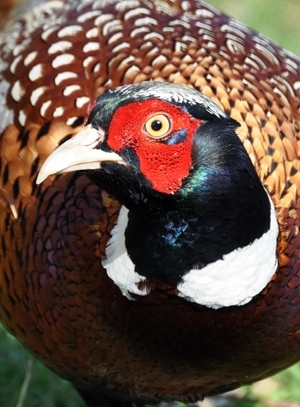Pheasant (Phasianus colchicus)
 The pheasant is surely one of the most recognisable birds in our countryside, especially the large male or “cock” bird with his strutting style and multi-coloured plumage, so often depicted amid a snowy scene on numerous Christmas cards.
The pheasant is surely one of the most recognisable birds in our countryside, especially the large male or “cock” bird with his strutting style and multi-coloured plumage, so often depicted amid a snowy scene on numerous Christmas cards.
Despite being so well known, the pheasant is of course not native to our shores, but originates from Asia. The first record of an introduction into Europe goes back to the story of Jason and the Argonauts who, in their search for the Golden Fleece, visited the valley of the River Phasis in the Colchis region of Georgia, an area east of the Black sea coast – hence the pheasant’s name, Phasianus colchicus.
They returned to Greece bearing pheasants and from there they began to be introduced to other parts of Europe. Almost certainly it was the Romans who first brought pheasants to the UK, but there is some debate over the success of various possible introductions, however it is generally agreed that pheasants were common by the 15th century.
The pheasant’s popularity is firmly linked with it being the key sporting game bird in this country, although this was not always the case, as the wild, indigenous grey partridge once held this claim. In 1900, the average “bag” of pheasants was approximately 25 per 250 acres, rising to almost 150 per 250 acres by the 1980s.
Today, the shooting industry is worth around £1.6 billion to UK economy and employs 70,000 people in full time jobs. The pheasant makes up around 80% of the game birds shot in the UK and as a direct result of the increase in the rearing of this bird, an estimated 35 million pheasants are now currently released each year, resulting in a total pheasant bag of around 15 million birds a year.
As game shooting became increasingly important in the latter half of the 19th Century, large parts of the British landscape were “designed” for sporting purposes, with many great estates managing their land not only for shooting, but also for hunting and fishing. A quote from Oliver Rackham, the leading authority on the British countryside, sums up the role that field sports played in how our landscape looks today. “A multitude of groves is maintained for shooting and hunting, without which they would vanish almost overnight (a point which opponents of these activities would do well to remember).”
Many of these woods continue to be managed for the benefit of the pheasant and indeed new woodlands continue to be planted to “enhance” the landscape for shooting purposes. The pheasant requires coppiced “open” woodland with a shrubby under-storey to thrive, which is actually the same habitat that many other species of wildlife also like. Surveys carried out in East Anglia have shown that butterfly numbers were 2.2 times greater and the number of species 1.5 times higher in game woods than non-game woods. Another study found that rides (wide tracks) comprised a higher proportion of woodland area in game woods (13%) than non-game woods (8%).
So, love or loathe the pheasant (it has on occasions been voted Britain’s thickest bird!) there is no doubt that this one species has had a bigger and more positive impact on the way our lowland landscape looks today than probably any other species – not a bad claim for a colourful invader from Asia!
Peter Thompson
Advisory
Read more from Peter Thompson at the Fresh from the Field blog.

Download Peter Thompson's essential 26-page book, featuring beautiful photography and detailed profiles of Britain's wildlife
Download FREE >